
The United States Capitol, often called The Capitol or the Capitol Building, is the meeting place of the United States Congress and the seat of the legislative branch of the U.S. federal government. It is located on Capitol Hill at the eastern end of the National Mall in Washington, D.C. Though no longer at the geographic center of the federal district, the Capitol forms the origin point for the district's street-numbering system and the district's four quadrants.

John Trumbull was an American artist of the early independence period, notable for his historical paintings of the American Revolutionary War, of which he was a veteran. He has been called "The Painter of the Revolution".
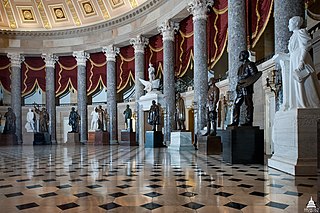
The National Statuary Hall is a chamber in the United States Capitol devoted to sculptures of prominent Americans. The hall, also known as the Old Hall of the House, is a large, two-story, semicircular room with a second story gallery along the curved perimeter. It is located immediately south of the Rotunda. The meeting place of the U.S. House of Representatives for nearly 50 years (1807–1857), after a few years of disuse in 1864 it was repurposed as a statuary hall; this is when the National Statuary Hall Collection was established. By 1933 the collection had outgrown this single room, and a number of statues are placed elsewhere within the Capitol.

John Edward Kenna was an American politician who was a Senator from West Virginia from 1883 until his death.

Pompeo Luigi Coppini was an Italian born sculptor who emigrated to the United States. Although his works can be found in Italy, Mexico and a number of U.S. states, the majority of his work can be found in Texas. He is particularly famous for the Alamo Plaza work Spirit of Sacrifice a.k.a. The Alamo Cenotaph, as well as numerous statues honoring Texan figures.

The Thomas Jefferson Building is the oldest of the four United States Library of Congress buildings, located on First Street SE between Independence Avenue and East Capitol Street in Washington, D.C. Built between 1890 and 1897, it was originally known as the Library of Congress Building. The Beaux-Arts style building is known for its classicizing facade and elaborately decorated interior. The building's main architect was Paul J. Pelz, initially in partnership with John L. Smithmeyer, and succeeded by Edward Pearce Casey during the last few years of construction. The building was designated a National Historic Landmark in 1965.
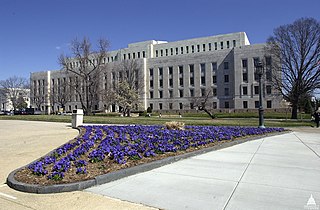
The John Adams Building is the second oldest of the four buildings of the Library of Congress of the United States. It is named for John Adams, the second president, who signed the law creating the Library of Congress. The building is in the Capitol Hill district of Washington D.C. next to the Library's main building. It opened to the public on January 3, 1939, and was long known as The Annex building. The annex was built in a restrained but very detailed Art Deco style and faced in white Georgia marble. It is located on Second Street SE between Independence Avenue and East Capitol Street in Washington, DC.

The United States Capitol rotunda is the tall central rotunda of the United States Capitol in Washington, D.C. It has been described as the Capitol's "symbolic and physical heart". Built between 1818 and 1824, the rotunda is located below the Capitol dome, which was built between 1857 and 1866.

Franklin Bachelder Simmons was a prominent American sculptor of the nineteenth century. Three of his statues are in the National Statuary Hall Collection, three of his busts are in the United States Senate Vice Presidential Bust Collection, and his statue of Ulysses S. Grant is in the United States Capitol Rotunda.

The Hall of Columns is a more than 100-foot-long (30 m) hallway lined with 28 fluted columns in the south wing extension of the United States Capitol in Washington, D.C. It is also the gallery for 18 statues of the National Statuary Hall Collection.
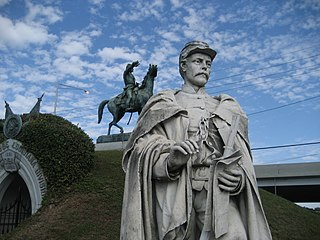
Alexander Doyle (1857–1922) was an American sculptor.
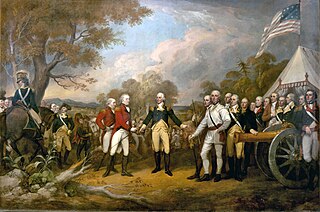
The Surrender of General Burgoyne is an oil painting by John Trumbull. The painting was completed in 1821, and hangs in the rotunda of the United States Capitol in Washington, D. C.

The Revolutionary War Door is an artwork by American sculptor Thomas Crawford, located on the United States Capitol House of Representatives wing east front in Washington, D.C., United States. This sculptured door was surveyed in 1993 as part of the Smithsonian's Save Outdoor Sculpture! program.
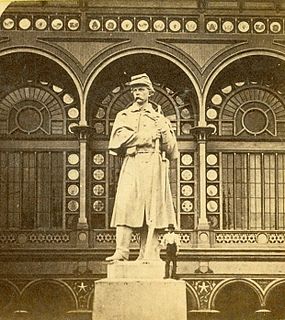
Carl H. Conrads was an American sculptor best known for his work on Civil War monuments and his two works in the National Statuary Hall Collection at the U.S. Capitol in Washington, D.C. He was also known as Charles Conrads.

Alexander H. Stephens is a marble sculpture commemorating the American politician of the same name by Gutzon Borglum, installed in the United States Capitol as part of the National Statuary Hall Collection. The statue was gifted by the state of Georgia in 1927.
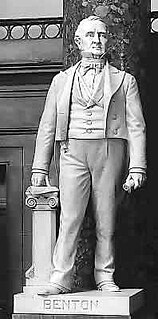
Thomas Hart Benton is a marble sculpture depicting the Senator from Missouri of the same name by Alexander Doyle, installed at the United States Capitol in Washington, D.C., as part of the National Statuary Hall Collection. The statue was gifted by the U.S. state of Missouri in 1899.

Francis Preston Blair Jr. is a marble sculpture depicting the American jurist, politician, and soldier of the same name by Alexander Doyle, installed in the United States Capitol's Hall of Columns, in Washington, D.C., as part of the National Statuary Hall Collection. The statue was gifted by the U.S. state of Missouri in 1899.

Jacob Collamer is a marble statue of Jacob Collamer by Preston Powers, installed in the United States Capitol, in Washington D.C., as part of the National Statuary Hall Collection. It is one of two statues donated by the state of Vermont. The statue was accepted in the collection by Alexander H. Stephens in 1881.

There are several works of art in the United States Capitol honoring former leaders of the Confederate States of America and generals in the Confederate States Army, including eight statues in the National Statuary Hall Collection, busts and portraits.
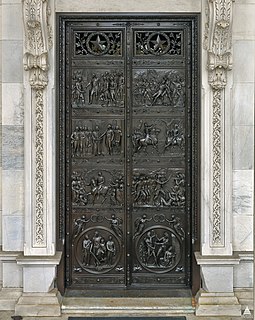
The George Washington and the Revolutionary War Door (1855–1868) is pair of a bronze sculptured doors to the Senate wing of the United States Capitol in Washington, D.C., United States. American sculptor Thomas Crawford designed and modeled the doors in the mid-1850s, but died prior to their completion. American sculptor William H. Rinehart completed the doors based on Crawford's designs.




















